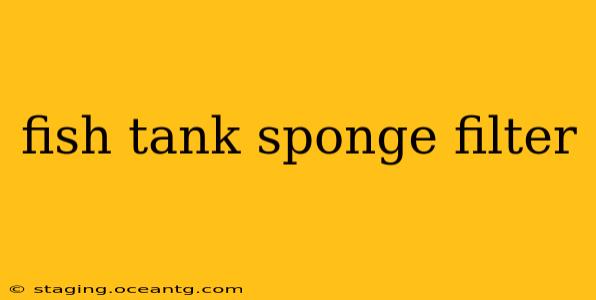A sponge filter is a simple yet effective filtration system for aquariums, particularly popular among beginners and those keeping smaller tanks. They're known for their gentle water flow, biological filtration capabilities, and ease of maintenance. This comprehensive guide will delve into everything you need to know about fish tank sponge filters, answering frequently asked questions and providing valuable insights for optimal aquarium health.
What is a Fish Tank Sponge Filter?
A fish tank sponge filter is a type of mechanical and biological filter that uses a porous sponge material to trap debris and house beneficial bacteria. Unlike other filter types, it doesn't require a powerhead or pump; instead, it relies on an air pump to create air bubbles that lift water through the sponge. The sponge acts as a filter media, trapping waste particles as the water passes through. Over time, beneficial bacteria colonize the sponge, breaking down harmful ammonia and nitrite into less toxic nitrates, a crucial part of the nitrogen cycle.
How Does a Sponge Filter Work?
The magic of a sponge filter lies in its simplicity and effectiveness. An air pump pushes air through an air line into a tube located within the filter. This creates bubbles that rise through the sponge, drawing water upwards. As the water travels through the sponge's pores, mechanical filtration occurs—larger debris and particles are trapped. Simultaneously, the sponge's large surface area provides ample space for beneficial bacteria to establish a colony, facilitating biological filtration.
What are the Benefits of Using a Sponge Filter?
- Gentle Water Flow: Perfect for delicate fish species and fry, minimizing stress and damage.
- Biological Filtration: Houses beneficial bacteria crucial for maintaining water quality.
- Quiet Operation: Unlike power filters, they operate silently, creating a peaceful environment.
- Easy Maintenance: Cleaning is straightforward, and replacements are affordable.
- Cost-Effective: Initial investment is low, making it an accessible option for aquarists.
- Suitable for Small Tanks: Ideal for nano tanks and smaller aquariums.
What Size Sponge Filter Do I Need?
The size of the sponge filter you need depends largely on the size of your aquarium. A general rule of thumb is to choose a filter that's roughly 1/4 to 1/3 the volume of your tank. However, factors like stocking levels (number of fish) and the amount of waste produced will influence your choice. It's always best to err on the side of slightly more filtration rather than less. Consult product specifications or ask a knowledgeable aquarist for guidance.
How Often Should I Clean a Sponge Filter?
Over-cleaning a sponge filter can disrupt the beneficial bacteria colony, leading to potential ammonia spikes. Generally, you should only clean the sponge every 2-4 weeks, or whenever it becomes visibly clogged. When cleaning, rinse the sponge gently in some of the old tank water, avoiding tap water (which contains chlorine and chloramine harmful to bacteria). Never use soap or other cleaning agents. For heavily soiled sponges, you might need to divide the cleaning process over several days, cleaning only a portion of the sponge at a time to maintain the beneficial bacterial colony.
Can I Use a Sponge Filter in a Planted Tank?
Yes, sponge filters are excellent for planted tanks. Their gentle water flow will not uproot delicate plants, and the biological filtration helps maintain a healthy environment for plant growth. However, make sure the air stone doesn't disturb the substrate too much and ensure enough space around the plants for good water circulation.
How to Choose the Best Sponge Filter for My Fish Tank?
Consider these factors when selecting a sponge filter:
- Tank Size: Match the filter's capacity to your aquarium's volume.
- Fish Species: Choose a filter appropriate for the size and sensitivity of your fish.
- Air Pump Compatibility: Ensure the filter is compatible with the air pump you intend to use.
- Ease of Maintenance: Opt for a filter with easy-to-clean components.
- Filter Material: Higher-quality sponges usually offer better filtration and durability.
Conclusion
Sponge filters offer a reliable, affordable, and efficient method of filtration for many aquarium setups. Their gentle water flow, ease of maintenance, and effectiveness make them a popular choice amongst aquarists of all experience levels. By understanding the principles of their operation and proper maintenance, you can ensure a healthy and thriving aquatic environment for your fish.
